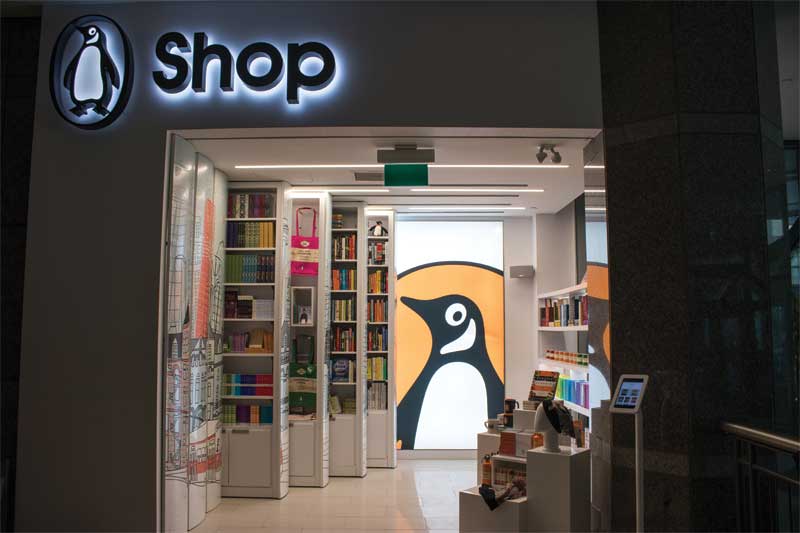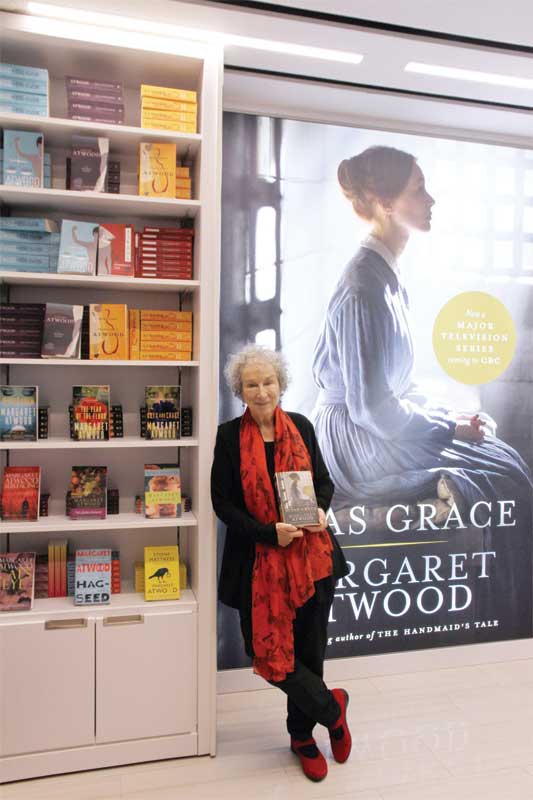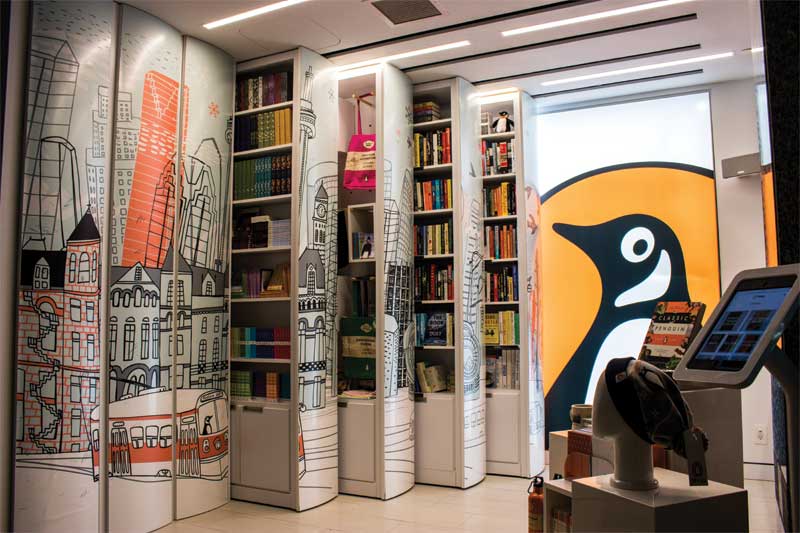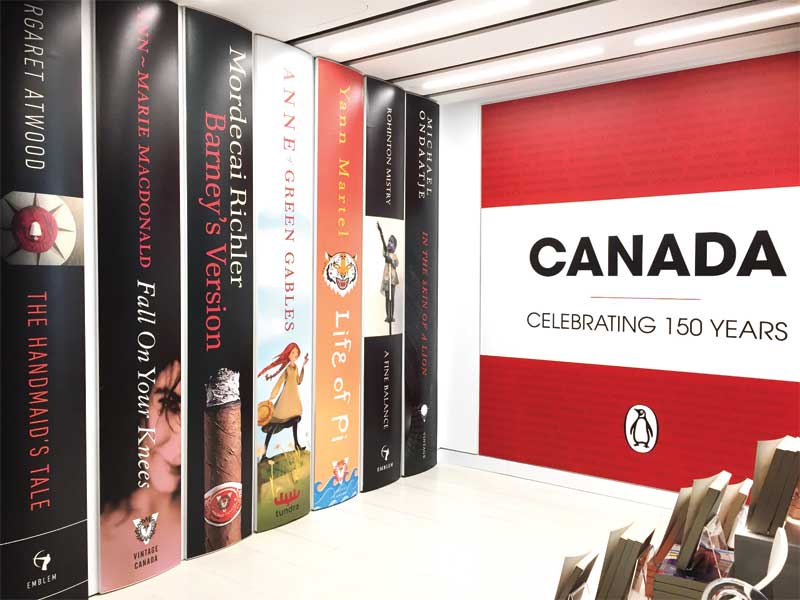POP Displays: Decorating the Penguin Shop
by all | 28 March 2018 2:10 pm
 [1]
[1]Photo courtesy Icon Digital
By Peter Saunders
In the competitive field of global retail design, downtown Toronto is currently home to a tiny store that has reportedly earned the most industry accolades per square foot: the Penguin Shop. This unique store came about after book publishers Penguin and Random House, previously direct competitors, decided to merge in 2013.
In Toronto, the combined operations of Penguin Random House (PRH) Canada moved into several floors of office space at 320 Front Street West. As it turned out, the lease for this space also included a 14.7-m2 (158-sf) shoe repair shop on the building’s ground floor, accessible from the main foyer.
“Our workplace studio was assigned to design the new PRH offices and the client was very happy with the results,” explains Mardi Najafi, director of the retail team for Figure3, a Toronto-based independent interior design studio. “About eight months later, they reached out to my team to discuss how they might transform the old shoe repair store into an extension of their brand.”
By this point, the publisher envisioned setting up a gift shop to sell branded merchandise and possibly a limited, specially curated selection of its books. Najafi expanded on this concept with large-format point-of-purchase (POP) graphics that would turn the space into a customized backdrop for book launches and other special events, perfect for sharing via social media.
“Compared to a typical gift shop, I wanted to give this tiny space some more flexibility,” he says, “so I came up with the concept of pulling out shelving units on rails that would resemble large-format books, displaying interchangeable graphics of Penguin book spines.”
 [2]
[2]The store has also been specially decorated for visiting authors, including Margaret Atwood.
Photos courtesy Figure3
One key factor that made this concept feasible was ready access to the necessary creative materials within PRH’s archives. Each time a publisher releases a new book, after all, it creates the graphic for that book’s spine.
“The client loved the idea of these large-scale books, which could be changed throughout the year,” says Najafi, “and they could pull out the different shelving units at different times.”
Bringing dynamism to static graphics
To transform the concept into reality, display graphics provider Icon Digital Productions in nearby Markham, Ont., worked closely
with Figure3 to ensure physical prints could adequately convey the design scheme. This process involved two months of colour testing and prototype production before finalizing and installing all of the graphics for the store’s launch in the summer of 2016.
In the end, Figure3 and Icon decided to use a changeable graphics system from Visual Magnetics. Classic Penguin book spines were printed onto magnetic-receptive paper, using a four-colour ultraviolet-curing (UV-curing) press, while magnetic sheets were permanently adhered to the sliding shelf fixtures. This way, new graphics could be printed as needed, transported inexpensively—due to their low weight—and easily installed on-site by PRH’s own staff, without any risk of damage to the shelves.
“The entire store can be changed over in less than an hour,” says Will Boake, Icon’s vice-president (VP) of sales. “It’s very do-it-yourself (DIY) and the old graphics can be reused. You can even apply layers on top of each other. If you just wanted to change the titles on the book spines, for example, you could do that with partial overlays. It’s a cost-effective way to incorporate frequent updates.”
For the back wall, meanwhile, Icon printed the Penguin logo onto Ultraflex’s stretchable and washable Vortex woven poly-blend fabric, using a Mimaki dye sublimation printer and a Monti Antonio heat press, and fit it into a silicone edge graphic (SEG) aluminum frame.
“That main graphic can also be changed out by people at the store level,” says Boake. “This can be done for special events or seasonally throughout the year.”
 [3]
[3]The magnetic book spine graphics adorn shelves that can be pulled out to display various types of merchandise.
For additional flexibility, the fabric is backlit with dimmable light-emitting diodes (LEDs).
“Based on what’s printed, the staff can change the lights’ colour temperature accordingly,” Najafi says.
Figure3’s original concept for the shop’s back wall was an interactive digital signage display, which would allow customers to browse through titles by swiping across a touch screen, much like a giant Apple iPad. While this proved too expensive for PRH’s budget, Najafi ensured the wall behind the backlit fabric graphic was hardwired to a media rack, so a video wall could be supported at some point in the future.
Designed for social media
Since the opening of the shop, PRH has indeed changed the graphics on a seasonal basis, as well as to highlight specific events and milestones, such as Canada 150, the 50th anniversary of its children’s imprint Tundra Books, the adaptation of Margaret Atwood’s Alias Grace as a TV series for CBC and the release of YouTube superstar Lilly Singh’s How To Be A Bawse.
“The specific setup depends on the author or the event,” says Anthony de Ridder, one of PRH’s in-house designers. “We can’t accommodate a big crowd here, but the shop works well as a staging backdrop for our social media posts. It’s very Instagrammable!”
That said, the store does welcome its share of customers in-person, including Penguin ‘superfans’ for whom it is a choice destination, professionals who work in the same office building—most of whom are with Toronto-Dominion (TD) Bank—and visitors to the city staying in nearby hotels, who find few other options for book shopping nearby.
 [4]
[4]The giant book spines have been charged out for such milestones as Canada 150 and the 50th anniversary of Penguin’s children’s imprint, Tundra.
Photo courtesy Penguin Shop
“The shop helps us connect with our readers at a small, intimate scale,” says Maggie Finlayson, the shop’s customer experience (CX) specialist. “Whenever I update our merchandising arrangement, I find people notice and react to it. It’s a good way for us to test out new products and ideas.”
The mix of products also helps ensure the sustainability of the shop’s business model, from book sales that increase dramatically before Christmas to Penguin-branded umbrellas that sell out on rainy days.
Noticed around the world
As mentioned, the project has earned many accolades, including an Interior Design magazine Best of Year Award in the retail (bookstore) category for 2016, the Association of Registered Interior Designers of Ontario’s (ARIDO’s) Project of the Year Award for 2017 and a Gold Award for Best In-Store Experience & Design at the 2017 GlobalShop trade show.
“Its impact has gone way beyond Canada’s borders,” says Najafi. “PRH is an international entity, with teams from New York to London that have been in awe of what the Toronto office has accomplished. They may end up extending this concept to their own showrooms or to new pop-up stores.”
With files from PRH Canada, Figure3 and Icon Digital Productions. For m ore information, visit www.figure3.com[5], www.penguinrandomhouse.ca[6], www.penguinshop.ca[7], and www.icondigital.com[8].
- [Image]: https://www.signmedia.ca/wp-content/uploads/2018/03/IMG_2574.jpg
- [Image]: https://www.signmedia.ca/wp-content/uploads/2018/03/Margaret-Atwood_penguin-Shop.jpg
- [Image]: https://www.signmedia.ca/wp-content/uploads/2018/03/IMG_2566.jpg
- [Image]: https://www.signmedia.ca/wp-content/uploads/2018/03/PenguinShop-CanLit-spines.jpg
- www.figure3.com: http://www.figure3.com
- www.penguinrandomhouse.ca: http://www.penguinrandomhouse.ca
- www.penguinshop.ca: http://www.penguinrandomhouse.ca
- www.icondigital.com: http://www.icondigital.com
Source URL: https://www.signmedia.ca/pop-displays-decorating-the-penguin-shop/